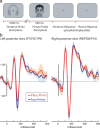The influence of language on perception: listening to sentences about faces affects the perception of faces
- PMID: 21068330
- PMCID: PMC6633823
- DOI: 10.1523/JNEUROSCI.2046-10.2010
The influence of language on perception: listening to sentences about faces affects the perception of faces
Abstract
We examined the effect of linguistic comprehension on early perceptual encoding in a series of electrophysiological and behavioral studies on humans. Using the fact that pictures of faces elicit a robust and reliable evoked response that peaks at ∼170 ms after stimulus onset (N170), we measured the N170 to faces that were preceded by primes that referred to either faces or scenes. When the primes were auditory sentences, the magnitude of the N170 was larger when the face stimuli were preceded by sentences describing faces compared to sentences describing scenes. In contrast, when the primes were visual, the N170 was smaller after visual primes of faces compared to visual primes of scenes. Similar opposing effects of linguistic and visual primes were also observed in a reaction time experiment in which participants judged the gender of faces. These results provide novel evidence of the influence of language on early perceptual processes and suggest a surprising mechanistic description of this interaction: linguistic primes produce content-specific interference on subsequent visual processing. This interference may be a consequence of the natural statistics of language and vision given that linguistic content is generally uncorrelated with the contents of perception.
Figures




Similar articles
-
Neural adaptation is related to face repetition irrespective of identity: a reappraisal of the N170 effect.Exp Brain Res. 2011 Mar;209(2):193-204. doi: 10.1007/s00221-011-2546-x. Epub 2011 Feb 3. Exp Brain Res. 2011. PMID: 21287156 Free PMC article.
-
The N170 observed 'in the wild': robust event-related potentials to faces in cluttered dynamic visual scenes.Soc Cogn Affect Neurosci. 2015 Jul;10(7):938-44. doi: 10.1093/scan/nsu136. Epub 2014 Oct 24. Soc Cogn Affect Neurosci. 2015. PMID: 25344945 Free PMC article.
-
Concurrent processing reveals competition between visual representations of faces.Neuroreport. 2004 Oct 25;15(15):2417-21. doi: 10.1097/00001756-200410250-00023. Neuroreport. 2004. PMID: 15640767
-
Early lateralization and orientation tuning for face, word, and object processing in the visual cortex.Neuroimage. 2003 Nov;20(3):1609-24. doi: 10.1016/j.neuroimage.2003.07.010. Neuroimage. 2003. PMID: 14642472 Clinical Trial.
-
Does physical interstimulus variance account for early electrophysiological face sensitive responses in the human brain? Ten lessons on the N170.Neuroimage. 2008 Feb 15;39(4):1959-79. doi: 10.1016/j.neuroimage.2007.10.011. Epub 2007 Oct 22. Neuroimage. 2008. PMID: 18055223 Review.
Cited by
-
Editing reality in the brain.Neurosci Conscious. 2022 Jul 23;2022(1):niac009. doi: 10.1093/nc/niac009. eCollection 2022. Neurosci Conscious. 2022. PMID: 35903411 Free PMC article. Review.
-
Unpredictive linguistic verbal cues accelerate congruent visual targets into awareness in a breaking continuous flash suppression paradigm.Atten Percept Psychophys. 2021 Jul;83(5):2102-2112. doi: 10.3758/s13414-021-02297-y. Epub 2021 Mar 30. Atten Percept Psychophys. 2021. PMID: 33786749 Free PMC article.
-
A comparison of reward processing during Becker-DeGroot-Marschak and Vickrey auctions: An ERP study.Psychophysiology. 2023 Sep;60(9):e14313. doi: 10.1111/psyp.14313. Epub 2023 Apr 19. Psychophysiology. 2023. PMID: 37076995 Free PMC article.
-
Spoken words affect visual object recognition via the modulation of alpha and beta oscillations.Front Neurosci. 2025 Apr 14;19:1467249. doi: 10.3389/fnins.2025.1467249. eCollection 2025. Front Neurosci. 2025. PMID: 40297533 Free PMC article.
-
Flexibility in embodied language understanding.Front Psychol. 2011 Jun 3;2:116. doi: 10.3389/fpsyg.2011.00116. eCollection 2011. Front Psychol. 2011. PMID: 21779264 Free PMC article.
References
-
- Aziz-Zadeh L, Wilson SM, Rizzolatti G, Iacoboni M. Congruent embodied representations for visually presented actions and linguistic phrases describing actions. Curr Biol. 2006;16:1818–1823. - PubMed
-
- Aziz-Zadeh L, Fiebach CJ, Naranayan S, Feldman J, Dodge E, Ivry RB. Modulation of the FFA and PPA by language related to faces and places. Soc Neurosci. 2008;3:229–238. - PubMed
-
- Bentin S, Mouchetant-Rostaing Y, Giard MH, Echallier JF, Pernier J. ERP manifestations of processing printed words at different psycholinguistic levels: time course and scalp distribution. J Cogn Neurosci. 1999;11:235–260. - PubMed
-
- Bentin S, Taylor MJ, Rousselet GA, Itier RJ, Caldara R, Schyns PG, Jacques C, Rossion B. Controlling interstimulus perceptual variance does not abolish N170 face sensitivity. Nat Neurosci. 2007;10:801–802; author reply 802–803. - PubMed
MeSH terms
LinkOut - more resources
Full Text Sources
